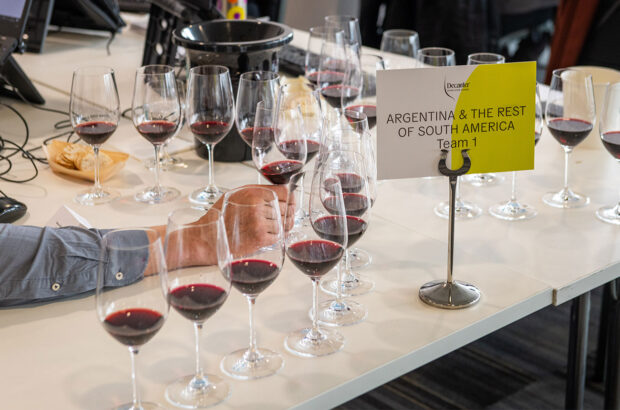Launched at London fine wine club 67 Pall Mall on 28 March, the Regenerative Viticulture Foundation (RVF) is the brainchild of Stephen Cronk, owner of Maison Mirabeau in Provence.
Cronk, who has seen extreme weather events ranging from exceptional frosts to the worst forest fires in living memory in the three years he has owned Mirabeau, feels that one of the most important ways we can fight climate change is through ‘unlearning’ current approaches to land stewardship.
‘This is a critical moment for the planet,’ he said. ‘We can’t carry on in the same old way. We need a paradigm shift in how we think.’

Launching the new foundation at 67 Pall Mall in London…Photo credit: Regenerative Viticulture Foundation.
Cronk was inspired by the inspirational work of Oregon wine grower Mimi Casteel to spread the word on how to transition from conventional viticulture to a more regenerative approach.
Casteel and Miguel Torres Jr of Penedes-based Familia Torres, which has played a pioneering role in inspiring the wine industry to be more proactive in tackling climate change, took part in a panel discussion on regenerative viticulture, introduced by Justin Howard-Sneyd MW and moderated by Dr Jamie Goode of Wineanorak.
Regenerative viticulture is about restoring the land, according to Howard-Sneyd, unlike more conventional approaches, which deplete soils, and sustainable viticulture, which has a neutral effect. ‘Soil is key to regenerative viticulture, but there is a lot we don’t understand about soil networks,’ he said.
Casteel sees it is a framework of ideas or a toolbox to help wine growers think like an ecosystem. ‘We need to empower people to feel like a part of the landscapes around them, so they understand what has been lost from the ecosystem that is stopping it from functioning properly and how we can put it back to keep the natural recycling of nutrients going.’
Goode described conventional viticulture as ‘input-heavy’, focusing on what is above the soil, rather than what is happening below it. ‘We need to see vineyards as agroecological systems. If you have soils that work, you have to put less in.’
The key thing that makes the regenerative approach different from other forms of sustainable viticulture like organic and biodynamic practices is its emphasis on not tilling vineyard soil.
Tilling is widely practised in organic vineyards, but leaving soil untilled can have numerous advantages, including increased biodiversity, which creates a more stable ecosystem; soil that is less compacted; better water retention; healthier underground networks of mycorrhizal fungi that circulate water and nutrients; and, potentially, more carbon capture in the soil.
Casteel founded her vineyard at Hope Well in Oregon’s Willamette Valley with the conviction that a ‘no-till’ approach to viticulture not only repairs ecosystems by reversing damage to soils and restoring natural cycles but also avoids releasing organic carbon stored in the soil. ‘Tilling the soil interrupts interactions between micro-organisms, which means that the soil loses its organic carbon very quickly.’
According to Torres, the topsoil in tilled vineyards is more easily washed away by heavy rainfall. ‘Planting cover crops helps the soil absorb water and provides a mulching effect, bringing the whole ecosystem to a higher level.’
Soils rich in organic matter retain more water and help to lower soil temperatures, creating a more resilient vineyard.
Casteel has experimented with bringing different animals into the vineyard, from sheep that graze cover crops between the vines to chickens that control pests.
One of the challenges has been to find the best ways of putting carbon into the soil. ‘Agricultural soils across the planet have lost 70-80% of their organic matter, so you need to jump-start the ecosystem,’ Casteel said.
Her answer has been to use biochar-fed pigs. Biochar, a carbon-rich biomass similar to charcoal, increases the fertilising effect of the pigs’ manure, while also improving their digestion. ‘After we brought in the pigs, the water-holding capacity of our vineyard went up exponentially in just one year – and we had some of our best-ever fruit.’
Transitioning to regenerative viticulture inevitably takes time, and Torres acknowledges that changing practices can increase costs: ‘It takes four to 10 years to get to the point where the ecosystem is stable.’
But the end result is a resilient vineyard. ‘There’s an initial investment, but so many advantages when you get there,’ said Casteel. ‘I was considered a lunatic when I first started. Now my phone rings off the hook, because wine growers have seen the effects on our vineyards.’
Cronk hopes that the Regenerative Viticulture Foundation (RVF) will help build momentum for regenerative approaches in the wine industry.
His wants the foundation to become an online resource – a toolbox of how to do things better – that can be shared widely among wine producers. ‘Wine has a powerful voice,’ said Casteel. ‘It’s time we started using it in a more responsible way.’







